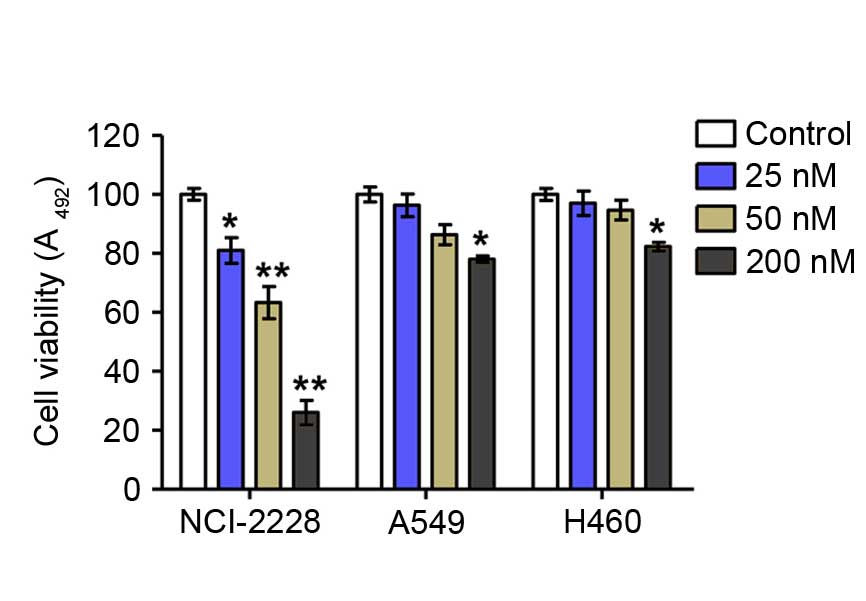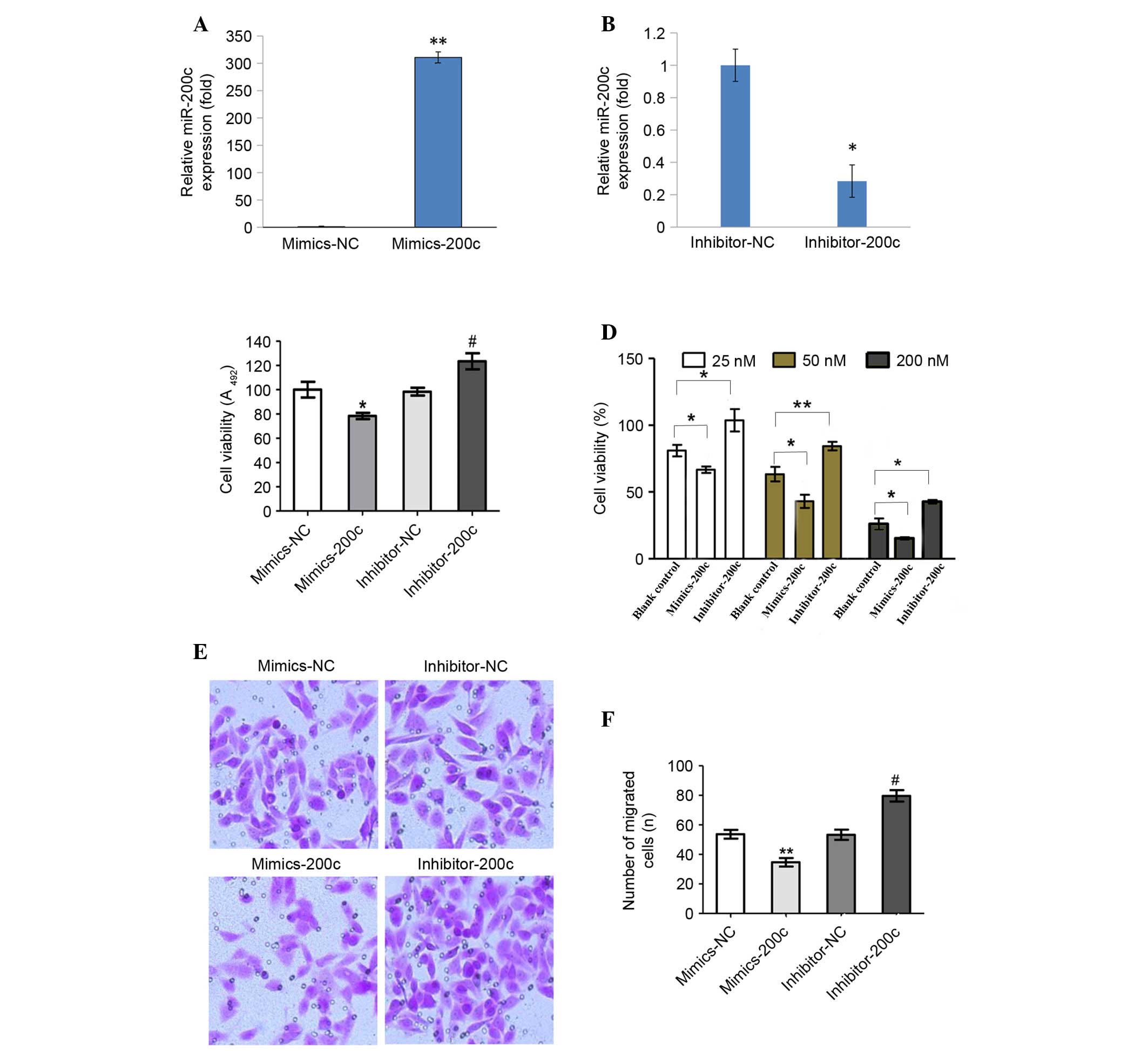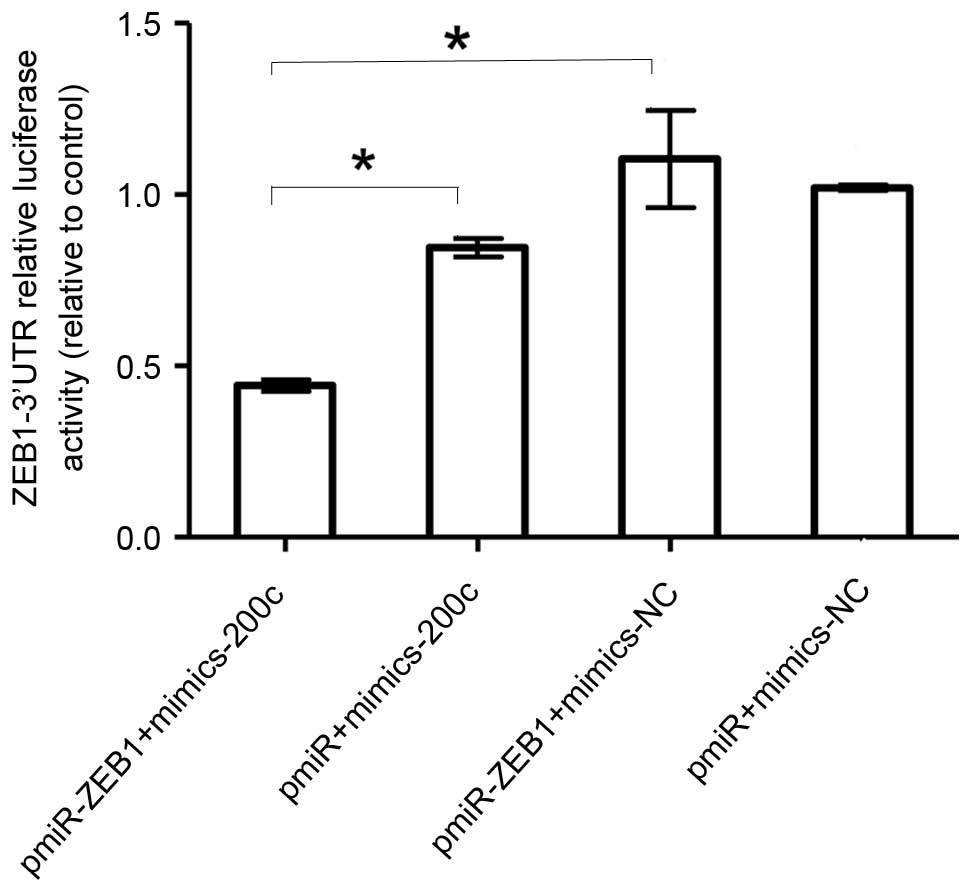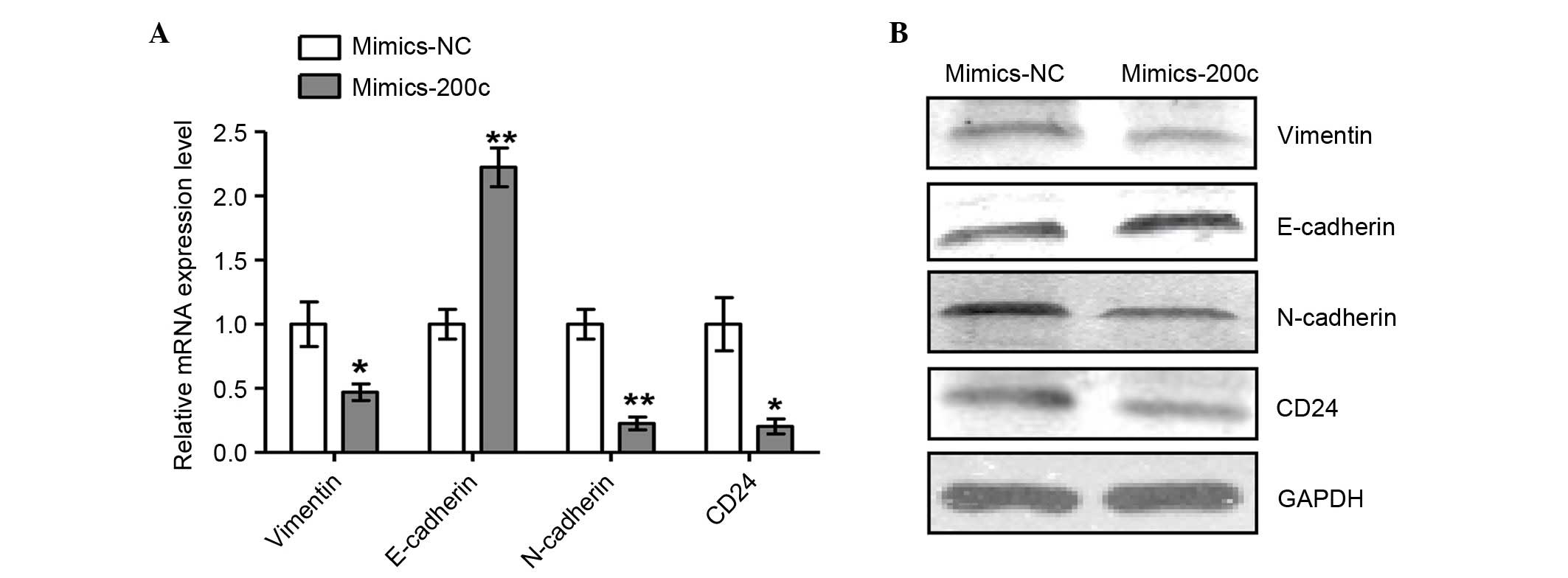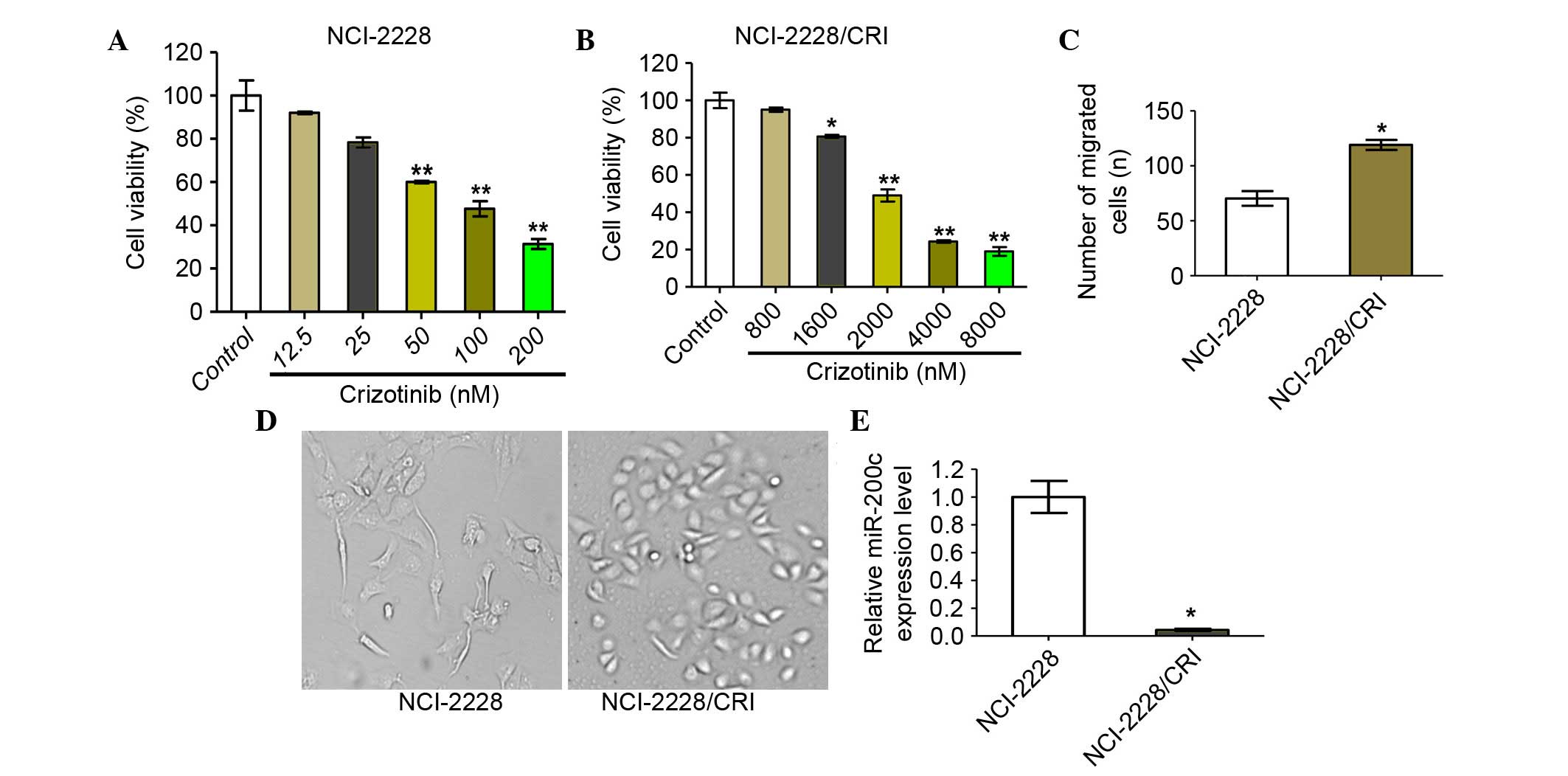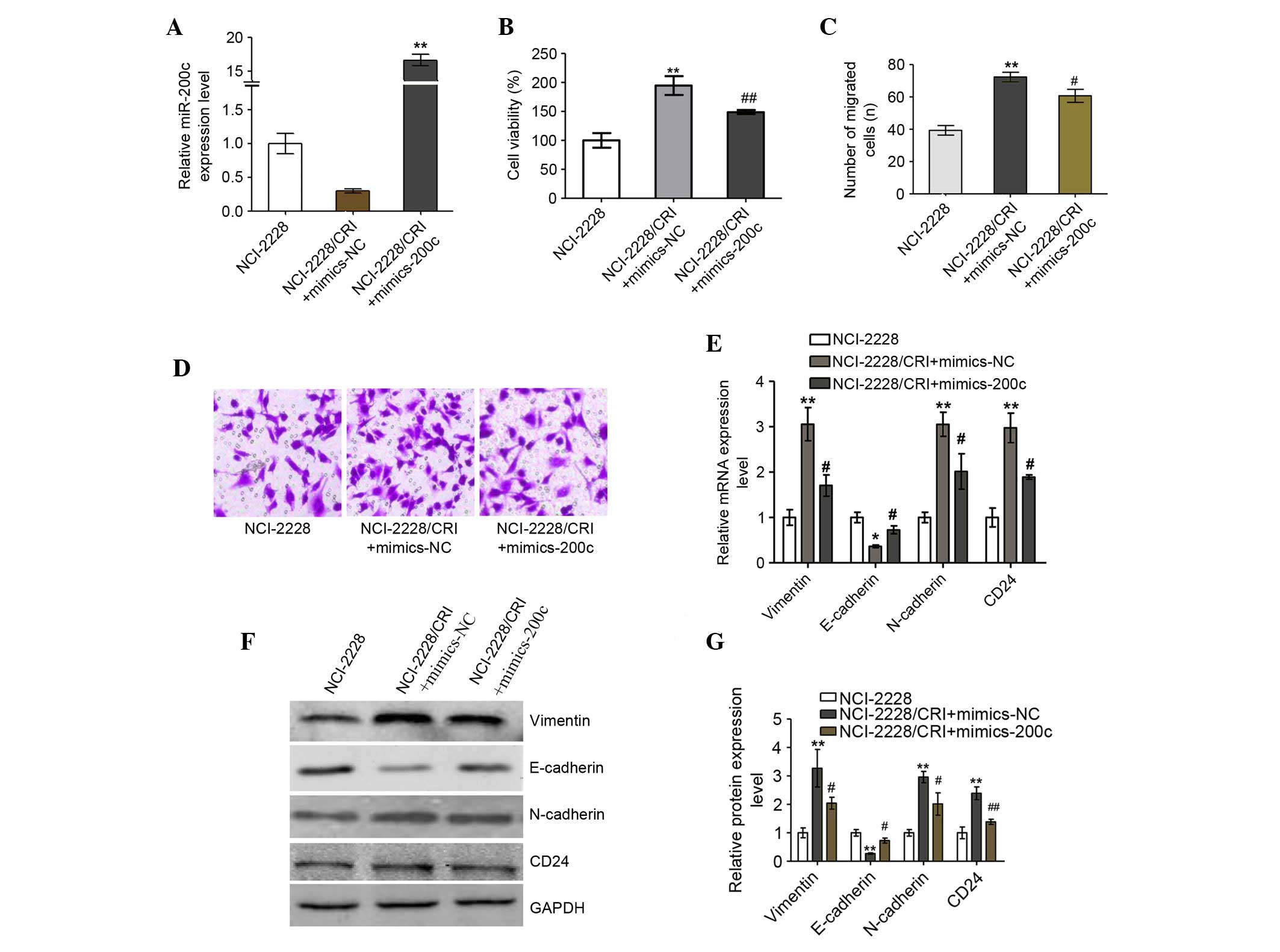miR-200c regulates crizotinib-resistant ALK-positive lung cancer cells by reversing epithelial-mesenchymal transition via targeting ZEB1
- Authors:
- Published online on: September 23, 2016 https://doi.org/10.3892/mmr.2016.5770
- Pages: 4135-4143
-
Copyright: © Gao et al. This is an open access article distributed under the terms of Creative Commons Attribution License.
Abstract
Introduction
Lung cancer is a malignant neoplasm associated with high morbidity and is the leading cause of cancer-associated mortality worldwide (1). Non-small cell lung cancer (NSCLC) accounts for 85% of all lung cancer cases (1–3). The majority of patients with NSCLC are elderly at the time of diagnosis (2). The five-year survival rate for NSCLC is 15%, which is reduced to 4% following the development of metastases (1), therefore research to prolong survival times for such patients is of vital importance.
Personalized therapy, based on the genetic characteristics of patients, is the most effective method for the treatment of lung cancer (2). Anaplastic lymphoma kinase (ALK) inhibitors such as crizotinib can be used to treat NSCLC successfully, greatly improving the prognosis of patients with lung cancer that have ALK gene mutations (3). Crizotinib is a tyrosine kinase inhibitor with activity against ALK, MET proto-oncogene receptor tyrosine kinase and ROS proto-oncogene 1 receptor tyrosine kinase (4). It was the first molecular targeted drug to undergo clinical development for the treatment of patients with ALK-positive advanced NSCLC, where it exhibited an objective response rate (ORR) of ~60% (5). Crizotinib has been approved for the treatment of patients with ALK-positive lung cancer by the Food and Drug Administration (6).
Recently, a clinical trial evaluated the effects of first-line crizotinib vs. pemetrexed-cisplatin in patients with advanced ALK-positive NSCLC and demonstrated that crizotinib resulted in increased progression-free survival and ORR, with fewer side effects (7). Crizotinib is, therefore, an attractive therapeutic option for patients with ALK-positive lung cancer (7,8).
However, in virtually all patients receiving crizotinib therapy, drug resistance occurs within approximately one year, via complex resistance mechanisms (9). New approaches for solving drug resistance and delaying its occurrence are therefore required, including investigating methods to increase the sensitivity of conventional treatments, including chemotherapy, radiation therapy and molecular targeted therapy.
An important member of the microRNA (miR)-200 family, miR-200c, exhibits low-expression in numerous tumor tissues and can regulate epithelial-mesenchymal transition (EMT), tumor invasion and metastasis (10–12). The overexpression of miR-200c in mesenchymal cells can promote mesenchymal-epithelial transition (MET) (11), and enhance the sensitivity of lung cancer cells to various chemotherapy drugs, epidermal growth factor receptor tyrosine kinase inhibitors and radiotherapy (13–15). In addition, previous reports have demonstrated that miR-200c regulates EMT by targeting ZEB1 and ZEB2 (11,16). However, whether it can improve the sensitivity of ALK-positive NCI-2228 lung cancer cells to crizotinib is unknown. In the present study, the regulation mechanism of miR-200c in ALK-positive lung cancer cells to crizotinib was investigated.
Materials and methods
Cell culture and treatment
NCI-2228 cells, echinoderm microtubule-associated protein-like 4-ALK positive lung cancer cells, were purchased from the American Type Culture Collection (Manassas, VA, USA). A549 cells and H460 cells were obtained from Basic Medical Research Institute, Chinese Academy of Medical Sciences (Beijing, China). Cells were cultured in RPMI1640/Dulbecco's modified Eagle's medium (DMEM; Gibco; Thermo Fisher Scientific, Inc., Waltham, MA, USA) supplemented with 10% fetal bovine serum (FBS; Shanghai Luo Biological Technology Co., Ltd., Shanghai, China) without antibiotics, and maintained in a humidified 5% CO2 atmosphere at 37°C.
To establish the crizotinib-resistant cell line, NCI-2228/CRI, 5 ml NCI-2228 cell suspension (1×106 cells/ml) was seeded in cell culture plates prior to treatment with 80 nM crizotinib (Sigma-Aldrich; Merck Millipore, Darmstadt, Germany) until >70% confluence was reached. The concentration of crizotinib was then increased to 160, 200, 300, 400, 500, 600, 700 and 800 nM on a bi-weekly basis. Following approximately six months of treatment, NCI-2228/CRI cells were resistant to 800 nM crizotinib.
Cell transfection
Transient transfection was performed using Lipofectamine 2000 Transfection Reagent (Invitrogen; Thermo Fisher Scientific, Inc., Waltham, MA, USA) according to the manufacturer's protocols. Briefly, ~1×104 cells were first seeded in cell culture plates. At 50% confluence, cells were transfected with miR-200c mimic or miR-200c inhibitor (cat. nos. 4464066 and 4464084, respectively; Invitrogen; Thermo Fisher Scientific, Inc.) using Lipofectamine 2000 transfection reagent in RPMI1640/DMEM without serum. Control reactions were simultaneously performed using the miR-200c mimic negative control (NC) or miR-200c inhibitor NC (cat. nos. 4464058 and 4464076, respectively; Invitrogen; Thermo Fisher Scientific, Inc.). At 24 h following transfection, cells were collected for subsequent experiments.
Cell viability and invasion assays
Cell viability was determined using the 3-[4,5-dimethylthiazol-2-yl]-2,5-diphenyltetrazolium bromide (MTT) assay. Cells in RPMI1640 culture medium were first seeded onto 96-well plates at a density of 5×103 cells/well and cultured for 24 h. The medium was then replaced with serum-free fresh medium plus crizotinib. NCI-2228 cells were treated with 0, 12.5, 25, 50, 100 and 200 nM crizotinib, whereas the drug-resistant NCI-2228/CRI cells were treated with 0, 800, 1,600, 2,000, 4,000 and 8,000 nM crizotinib. Following 48 h incubation, 100 µl MTT was added to each well and the cells were incubated for a further 4 h. The medium was subsequently discarded before 100 µl of 10% sodium dodecyl sulfate (SDS) was added into each well, and the absorbance was read at 492 nm using the Multiskan FC Microplate Photometer (Thermo Fisher Scientific, Inc.). The half maximal inhibitory concentration (IC50) was calculated using SPSS (SPSS, Inc., Chicago, IL, USA). All experiments were performed in triplicate.
The invasion assay was performed using Transwell inserts in 24-well dishes as described previously (17). For each Transwell, the number of migrated cells in five random fields of view were counted using a light microscope.
RNA extraction and reverse transcription-quantitative polymerase chain reaction (RT-qPCR)
Total RNA of cells was extracted using TRIzol reagent (Invitrogen; Thermo Fisher Scientific, Inc.) according to the manufacturer's protocols. Total RNA (1 µg) was used to generate the first strand cDNA using RevertAid™ First Strand cDNA Synthesis kit (Fermentas; Thermo Fisher Scientific, Inc., Waltham, MA, USA), for 1 h at 42°C. qPCR reactions were performed using Go Taq® Green Master Mix (Promega Corporation, Madison, WI, USA) according to the manufacturer's protocol. Thermal cycling conditions were as follows: Denaturation for 2 min at 95°C followed by 40 cycles of 95°C for 15 sec, 60°C for 1 min and 72°C for 1–2 min. The mRNA expression levels of GAPDH were used as the internal control. The relative expression levels of each target gene were calculated using the 2-ΔΔCq method (18). Sequences for the PCR primers used are presented in Table I.
Luciferase reporter assay
The 3′-untranslated region (UTR) for zinc finger E-box binding homeobox 1 (ZEB1) was PCR-amplified from genomic DNA as described previously (19), and inserted downstream of the firefly luciferase gene in the pmiR-REPORT or the pmiR control plasmid (Applied Biosystems; Thermo Fisher Scientific, Inc.). The PCR primers used to amplify the ZEB1 3′-UTR are presented in Table I. NCI-2228 cells were co-transfected with 2 µg of the firefly luciferase reporter vector and 0.5 µg of the control pRL-TK vector containing Renilla luciferase (Promega Corporation) using Lipofectamine 2000 (Invitrogen; Thermo Fisher Scientific, Inc.) according to the manufacturer's instructions. For each group, 20 nM of the miR-200c mimic or miR-200c mimic negative control was used. Following 48 h transfection, cells were lysed by incubating with 500 µl lysis buffer (Promega Corporation) for 15 min. The firefly and Renilla luciferase activities were then measured using the GloMax 96 Microplate Luminometer (Promega Corporation) and the Dual-Luciferase Reporter assay system (Promega Corporation) according to the manufacturer's protocols.
Western blot analysis
Transfected cells were harvested for immunoblot analysis following 72 h incubation. Cells were lysed in lysis buffer (Beyotime Institute of Biotechnology, Jiangsu, China). The protein concentration of cell lysates was determined by using Bio-Rad Protein Assay (Bio-Rad Laboratories, Inc., Hercules, CA, USA) according to the manufacturer's protocols. Proteins (15 µg) were separated by SDS-polyacrylamide gel electrophoresis on 10–15% gels and transferred to polyvinylidene fluoride membranes. Membranes were blocked with 8% non-fat dry milk for 1 h at room temperature before they were immunoblotted overnight at 4°C with the following primary antibodies: Glyceraldehyde 3-phosphate dehydrogenase (GAPDH; dilution, 1:1,000; cat. no. 10494-1-AP; ProteinTech Group, Inc., Chicago, IL, USA), E-cadherin (dilution, 1:1,000; cat. no. 20874-1-AP; ProteinTech Group, Inc.), N-cadherin (dilution, 1:1,000; cat. no. 13769-1-AP; ProteinTech Group, Inc.), Vimentin (dilution, 1:1,000; cat. no. 10366-1-AP; ProteinTech Group Inc.) and CD24 (dilution, 1:1,000; cat. no. 18330-1-AP; ProteinTech Group, Inc.), ZEB1 (dilution, 1:2,000; cat. no. sc-25388; Santa Cruz Biotechnology, Inc., Dallas, TX, USA) and ZEB2 (dilution, 1:2,000; cat. no. sc-48789; Santa Cruz Biotechnology, Inc.). After washing three times with phosphate-buffered saline plus 0.05% Tween-20, the membrane was incubated with the horseradish peroxidase-conjugated IgG secondary antibody (dilution, 1:1,000; cat. no. RPN4301; GE Healthcare Life Sciences, Shanghai, China) for 2 h at room temperature. Signals were detected with UltraECL Western Blot Detection reagent (Beyotime Institute of Biotechnology) and images visualized on Kodak film (Kodak, Rochester, NY, USA) and quantified with Quantity One Software version 4.4 (Bio-Rad Laboratories Inc.). All experiments were performed in triplicate.
Statistical analysis
All data are expressed as the mean ± standard deviation. All analysis was performed using SPSS version 13.5 (SPSS, Inc.). Comparisons of continuous measurement data were conducted with Student's t-test. Comparisons among treatment groups and controls were conducted using one-way analysis of variance with a post-hoc Tukey test. P<0.05 was considered to indicate a statistically significant difference.
Results
Crizotinib reduces lung cancer cell viability of NCI-2228
Assessment of cell viability by MTT assay revealed that crizotinib significantly inhibited the proliferation of NCI-2228 cells in vitro in a dose-dependent manner compared with untreated control cells (5 nM, P=0.016; 10 nM, P=0.001; 20 nM, P=0.002), but had only a weak inhibitory effect on the viability of A549 and H640 cells compared with untreated control (Fig. 1).
miR-200c inhibits proliferation, migration and invasion of NCI-2228 cells
NCI-2228 cells were utilized to elucidate the regulatory mechanism of miR-200c expression in NSCLC. NCI-2228 cells were treated with miR-200c mimic, miR-200c inhibitor, miR-200c mimic NC or miR-200c inhibitor NC, with expression of miR-200c subsequently analyzed by RT-qPCR (Fig. 2A and B). Compared with the mimic NC, miR-200c expression levels increased 310-fold following transfection with miR-200c mimic (P=0.001; Fig. 2A), while miR-200c expression levels decreased 3.5-fold following transfection with miR-200c inhibitor, compared with the inhibitor NC (P=0.033; Fig. 2B).
Cell viability (Fig. 2C and D) and invasion assays (Fig. 2E and F) demonstrated that transfection with miR-200c mimic significantly inhibited cell viability (P=0.036; Fig. 2C). With increasing concentrations of miR-200c mimic, a significant decrease in the viability of cells exposed to 25, 50 and 200 nM crizotinib was observed (P=0.011, P=0.038 and P=0.025, respectively; Fig. 2D). In addition, the migration and invasion capabilities of NCI-2228 cells were inhibited when compared with mimic NC (P=0.009; Fig. 2F). By contrast, transfection with miR-200c inhibitors significantly enhanced cell viability (P=0.027) and invasion (P=0.017) compared with the inhibitor NC.
miR-200c targets ZEB1 in NCI-2228 cells directly
To understand how miR-200c suppresses lung cancer migration and invasion, the coaction of miR-200c and miR-200c target of E-cadherin transcriptional repressor, ZEB1, were analyzed by luciferase reporter assay. The miR-200c was transfected with the ZEB1 3′-UTR luciferase reporter gene into NCI-2228 cells. The results demonstrated that the luciferase activity of pmiR-ZEB1 was significantly decreased following transfection of miR-200c mimics when compared with cells transfected with pmiR-ZEB1+mimics-NC (P=0.01; Fig. 3).
Increased miR-200c reverses EMT in NCI-2228 cells
To further examine the regulation of miR-200c expression in NCI-2228 cells, the miR-200c was overexpressed through transfection with miR-200c mimic, and the mRNA (Fig. 4A) and protein (Fig. 4B) expression levels of epithelial and mesenchymal cells markers analyzed. Expression levels of mesenchymal markers N-cadherin, Vimentin and CD24 were significantly decreased when compared with NC (P=0.004, P=0.045 and P=0.021, respectively), while expression of the epithelial marker E-cadherin was increased following transfection with miR-200c mimic (P=0.003) compared with mimics NC, suggesting that EMT was reversed in NCI-2228 cells upon overexpression of miR-200c.
NCI-2228/CRI cells exhibit higher proliferation, migration and invasion rates
The crizotinib-resistant cell line, NCI-2228/CRI, was successfully established in approximately six months, with NCI-2228/CRI cells displaying viable growth in high concentrations of crizotinib compared with the parental cell line, NCI-2228 (Fig. 5A and B). Furthermore, the NCI-2228/CRI cells displayed a certain degree of resistance to the ALK inhibitor LDK378 and chemotherapeutic drugs, paclitaxel and cisplatin (data not shown). NCI-2228/CRI cells exhibited increased invasion rates compared with NCI-2228 (P=0.035; Fig. 5C) and appeared spindle-shaped compared to the oval shape of NCI-2228 cells (Fig. 5D). In addition, the relative expression of miR-200c in NCI-2228/CRI cells was also demonstrated to be reduced by 24.93-fold when compared with NCI-2228 cells (P=0.014; Fig. 5E).
EMT occurs in NCI-2228/CRI cells
To elucidate the resistance mechanism of NCI-2228/CRI cells to crizotinib, the mRNA (Fig. 6A) and protein (Fig. 6B) expression levels of epithelial and mesenchymal cell markers were analyzed. The mRNA expression levels of N-cadherin and Vimentin were increased in NCI-2228/CRI cells compared with the parental cell line (P=0.004 and P=0.013, respectively; Fig. 5A), while E-cadherin was decreased in NCI-2228/CRI cells (P=0.017; Fig. 5A). The same trends in protein expression were also observed (Fig. 6B). In addition, the mRNA levels of ZEB1 and ZEB2 (transcription factors involved in EMT) were increased in NCI-2228/CRI cells compared with NCI-2228 (P=0.009 and P=0.003, respectively; Fig. 6A), with increased protein expression similarly observed by western blotting (Fig. 6B). The present study, therefore, suggests that EMT occurs in NCI-2228/CRI cells.
Increased miR-200c improves the sensitivity of NCI-2228/CRI to crizotinib
The function of miR-200c in NCI-2228/CRI cells was assessed by introducing miR-200c mimics to the cell line, resulting in significantly increased miR-200c mRNA levels (P=0.001; Fig. 7A) and significantly reduced viability of NCI-2228/CRI cells (P=0.008; Fig. 7B) compared with mimics NC. In addition, miR-200c inhibited the migration and invasion of NCI-2228/CRI cells compared with cells transfected with mimics NC (P=0.038; Fig. 7C and D). Analysis of mRNA (Fig. 7E) and protein (Fig. 7F and G) expression levels of epithelial and mesenchymal cell markers revealed that overexpression of miR-200c in NCI-2228/CRI cells resulted in decreased expression of N-cadherin (mRNA, P=0.032; protein, P=0.048), Vimentin (mRNA, P=0.035; protein, P=0.018) and CD24 (mRNA, P=0.030; protein, P=0.004) compared with NC, and increased expression of E-cadherin compared with NC (mRNA, P=0.017; protein, P=0.03). Overexpression of miR-200c therefore appears to reverse EMT to MET in NCI-2228/CRI cells, which may result in improved sensitivity of NCI-2228/CRI cells to crizotinib.
Discussion
It is widely accepted that the miR-200 family are involved in the proliferation, invasion, metastasis and drug resistance of various types of tumor (19–26). As an important member of the miR-200 family, miR-200c displays low expression in numerous tumor tissues, and can regulate EMT, tumor invasion and metastasis (10–12). However, few studies examining the effect of miR-200c in the resistance of crizotinib have been conducted. The present study reported that miR-200c expression was significantly lower in NCI2228/CRI cells compared with NCI2228 cells, suggesting that miR-200c may be associated with resistance to crizotinib.
EMT is associated with acquired crizotinib resistance (27,28). In the present study, overexpression of miR-200c was demonstrated to increase the expression of E-cadherin, and decrease the expression of Vimentin and N-cadherin. The results indicated that EMT was reversed in NCI-2228. In addition, morphological changes to the spindle-cell shape of NCI-2228 were observed in NCI-2228/CRI cells compared with parental cells, and were accompanied by a decrease in E-cadherin, and increase in N-cadherin and Vimentin expression, indicating the occurrence of EMT in NCI-2228/CRI cells. Furthermore, invasion and migration capabilities were significantly increased in NCI-2228/CRI cells compared with the parental NCI-2228 cell line. The authors speculate that overexpression of miR-200c in NCI-2228/CRI cells may serve a role in improving the sensitivity of cells to crizotinib. Moreover, NCI-2228/CRI cells exhibited resistance to conventional chemotherapy drugs, such as paclitaxel, cisplatin and the next-generation ALK tyrosine kinase inhibitor LDK378, which is similar to the previous report (data not shown) (28). The changes to EMT marker expression levels also suggested that EMT is involved in resistance to drugs, including chemotherapeutics and molecular targeted drugs (28,29).
Drug resistance mechanisms are divided into pharmacological and biological mechanisms (9). Regulation of EMT by miR-200c has been previously demonstrated to be mediated by a negative feedback loop targeting ZEB1 or ZEB2 (11,30). ZEB1 and ZEB2 mediate EMT by repressing the transcription of E-cadherin in order to enhance cell migration and invasion (31–33). The present study examined the mechanism by which miR-200c regulates migration and invasion in NCI-2228 cells and demonstrated that miR-200c directly targets ZEB1, thereby increasing E-cadherin expression in NCI-2228 cells. This suggests that miR-200c inhibits migration and invasion of NCI-2228 cells indirectly by upregulating E-cadherin through direct targeting of ZEB1. Expression of ZEB1 and ZEB2 was also observed to be higher in NCI-2228/CRI cells compared with NCI-2228 cells, and was accompanied by decreased expression levels of E-cadherin. The evidence, therefore, suggests that miR-200c is involved in preventing EMT in NCI-2228 cells through targeting of ZEB1.
In summary, EMT may represent an acquired resistance mechanism associated with crizotinib treatment. Migration and invasion of NCI-2228 cells can be inhibited by miR-200c through direct targeting of ZEB1 and indirect upregulation of E-cadherin. The results of the present study suggest that overexpression of miR-200c may improve crizotinib sensitivity by reversing EMT. The miR-200c may, therefore, serve as a potent target for therapy, which warrants further investigation using clinical samples.
Acknowledgements
The present study was supported by the Medical Research Key Project Plan of Hebei Province (grant no. 20160065). The authors thank the Institute of Basic Medical Sciences, Chinese Academy of Medical Sciences (Beijing, China) for providing the A549 and H460 cell lines.
References
|
Molina JR, Yang P, Cassivi SD, Schild SE and Adjei AA: Non-small cell lung cancer: Epidemiology, risk factors, treatment and survivorship. Mayo Clin Proc. 83:584–594. 2008. View Article : Google Scholar : PubMed/NCBI | |
|
Blanco R, Maestu I, de la Torre MG, Cassinello A and Nuñez I: A review of the management of elderly patients with non-small-cell lung cancer. Ann Oncol. 26:451–463. 2015. View Article : Google Scholar : PubMed/NCBI | |
|
Zimmermann S, Dziadziuszko R and Peters S: Indications and limitations of chemotherapy and targeted agents in non-small cell lung cancer brain metastases. Cancer Treat Rev. 40:716–722. 2014. View Article : Google Scholar : PubMed/NCBI | |
|
Rothschild SI and Gautschi O: Crizotinib in the treatment of non-small-cell lung cancer. Clin Lung Cancer. 14:473–480. 2013. View Article : Google Scholar : PubMed/NCBI | |
|
Kwak EL, Bang YJ, Camidge DR, Shaw AT, Solomon B, Maki RG, Ou SH, Dezube BJ, Jänne PA, Costa DB, et al: Anaplastic lymphoma kinase inhibition in non-small-cell lung cancer. N Engl J Med. 363:1693–1703. 2010. View Article : Google Scholar : PubMed/NCBI | |
|
Malik SM, Maher VE, Bijwaard KE, Becker RL, Zhang L, Tang SW, Song P, Liu Q, Marathe A, Gehrke B, et al: US Food and Drug Administration approval: Crizotinib for treatment of advanced or metastatic non-small cell lung cancer that is anaplastic lymphoma kinase positive. Clin Cancer Res. 20:2029–2034. 2014. View Article : Google Scholar : PubMed/NCBI | |
|
Solomon BJ, Mok T, Kim DW, Wu YL, Nakagawa K, Mekhail T, Felip E, Cappuzzo F, Paolini J, Usari T, et al: First-line crizotinib versus chemotherapy in ALK-positive lung cancer. N Engl J Med. 371:2167–2177. 2014. View Article : Google Scholar : PubMed/NCBI | |
|
Lindeman NI, Cagle PT, Beasley MB, Chitale DA, Dacic S, Giaccone G, Jenkins RB, Kwiatkowski DJ, Saldivar JS, Squire J, et al: Molecular testing guideline for selection of lung cancer patients for EGFR and ALK tyrosine kinase inhibitors: Guideline from the college of American pathologists, international association for the study of lung cancer and association for molecular pathology. Arch Pathol Lab Med. 137:828–860. 2013. View Article : Google Scholar : PubMed/NCBI | |
|
Iacono D, Chiari R, Metro G, Bennati C, Bellezza G, Cenci M, Ricciuti B, Sidoni A, Baglivo S, Minotti V and Crinò L: Future options for ALK-positive non-small cell lung cancer. Lung Cancer. 87:211–219. 2015. View Article : Google Scholar : PubMed/NCBI | |
|
Bracken CP, Gregory PA, Kolesnikoff N, Bert AG, Wang J, Shannon MF and Goodall GJ: A double-negative feedback loop between ZEB1-SIP1 and the microRNA-200 family regulates epithelial-mesenchymal transition. Cancer Res. 68:7846–7854. 2008. View Article : Google Scholar : PubMed/NCBI | |
|
Gregory PA, Bert AG, Paterson EL, Barry SC, Tsykin A, Farshid G, Vadas MA, Khew-Goodall Y and Goodall GJ: The miR-200 family and miR-205 regulate epithelial to mesenchymal transition by targeting ZEB1 and SIP1. Nat Cell Biol. 10:593–601. 2008. View Article : Google Scholar : PubMed/NCBI | |
|
Korpal M, Lee ES, Hu G and Kang Y: The miR-200 family inhibits epithelial-mesenchymal transition and cancer cell migration by direct targeting of E-cadherin transcriptional repressors ZEB1 and ZEB2. J Biol Chem. 283:14910–14914. 2008. View Article : Google Scholar : PubMed/NCBI | |
|
Cochrane DR, Spoelstra NS, Howe EN, Nordeen SK and Richer JK: MicroRNA-200c mitigates invasiveness and restores sensitivity to microtubule-targeting chemotherapeutic agents. Mol Cancer Ther. 8:1055–1066. 2009. View Article : Google Scholar : PubMed/NCBI | |
|
Bryant JL, Britson J, Balko JM, Willian M, Timmons R, Frolov A and Black EP: A microRNA gene expression signature predicts response to erlotinib in epithelial cancer cell lines and targets EMT. Br J Cancer. 106:148–156. 2012. View Article : Google Scholar : PubMed/NCBI | |
|
Shi L, Zhang S, Wu H, Zhang L, Dai X, Hu J, Xue J, Liu T, Liang Y and Wu G: MiR-200c increases the radiosensitivity of non-small-cell lung cancer cell line A549 by targeting VEGF-VEGFR2 pathway. PloS One. 8:e783442013. View Article : Google Scholar : PubMed/NCBI | |
|
Park SM, Gaur AB, Lengyel E and Peter ME: The miR-200 family determines the epithelial phenotype of cancer cells by targeting the E-cadherin repressors ZEB1 and ZEB2. Genes Dev. 22:894–907. 2008. View Article : Google Scholar : PubMed/NCBI | |
|
Tang H, Deng M, Tang Y and Xie X, Guo J, Kong Y, Ye F, Su Q and Xie X: miR-200b and miR-200c as prognostic factors and mediators of gastric cancer cell progression. Clin Cancer Res. 19:5602–5612. 2013. View Article : Google Scholar : PubMed/NCBI | |
|
Livak KJ and Schmittgen TD: Analysis of relative gene expression data using real-time quantitative PCR and the 2(−Delta Delta C (T)) Method. Methods. 25:402–408. 2001. View Article : Google Scholar : PubMed/NCBI | |
|
Zhou X, Wang Y, Shan B, Han J, Zhu H, Lv Y, Fan X, Sang M, Liu XD and Liu W: The downregulation of miR-200c/141 promotes ZEB1/2 expression and gastric cancer progression. Med Oncol. 32:4282015. View Article : Google Scholar : PubMed/NCBI | |
|
Paterson EL, Kazenwadel J, Bert AG, Khew-Goodall Y, Ruszkiewicz A and Goodall GJ: Down-regulation of the miRNA-200 family at the invasive front of colorectal cancers with degraded basement membrane indicates EMT is involved in cancer progression. Neoplasia. 15:180–191. 2013. View Article : Google Scholar : PubMed/NCBI | |
|
Tamagawa S, Beder LB, Hotomi M, Gunduz M, Yata K, Grenman R and Yamanaka N: Role of miR-200c/miR-141 in the regulation of epithelial-mesenchymal transition and migration in head and neck squamous cell carcinoma. Int J Mol Med. 33:879–886. 2014.PubMed/NCBI | |
|
van Jaarsveld MT, Helleman J, Boersma AW, van Kuijk PF, van Ijcken WF, Despierre E, Vergote I, Mathijssen RH, Berns EM, Verweij J, et al: miR-141 regulates KEAP1 and modulates cisplatin sensitivity in ovarian cancer cells. Oncogene. 32:4284–4293. 2013. View Article : Google Scholar : PubMed/NCBI | |
|
Gregory PA, Bracken CP, Smith E, Bert AG, Wright JA, Roslan S, Morris M, Wyatt L, Farshid G, Lim YY, et al: An autocrine TGF-beta/ZEB/miR-200 signaling network regulates establishment and maintenance of epithelial-mesenchymal transition. Mol Biol Cell. 22:1686–1698. 2011. View Article : Google Scholar : PubMed/NCBI | |
|
Vrba L, Jensen TJ, Garbe JC, Heimark RL, Cress AE, Dickinson S, Stampfer MR and Futscher BW: Role for DNA methylation in the regulation of miR-200c and miR-141 expression in normal and cancer cells. PloS One. 5:e86972010. View Article : Google Scholar : PubMed/NCBI | |
|
Xu Y, Brenn T, Brown ER, Doherty V and Melton DW: Differential expression of microRNAs during melanoma progression: miR-200c, miR-205 and miR-211 are downregulated in melanoma and act as tumour suppressors. Br J Cancer. 106:553–561. 2012. View Article : Google Scholar : PubMed/NCBI | |
|
Wiklund ED, Bramsen JB, Hulf T, Dyrskjøt L, Ramanathan R, Hansen TB, Villadsen SB, Gao S, Ostenfeld MS, Borre M, et al: Coordinated epigenetic repression of the miR-200 family and miR-205 in invasive bladder cancer. Int J Cancer. 128:1327–1334. 2011. View Article : Google Scholar : PubMed/NCBI | |
|
Kim HR, Kim WS, Choi YJ, Choi CM, Rho JK and Lee JC: Epithelial-mesenchymal transition leads to crizotinib resistance in H2228 lung cancer cells with EML4-ALK translocation. Mol Oncol. 7:1093–1102. 2013. View Article : Google Scholar : PubMed/NCBI | |
|
Kogita A, Togashi Y, Hayashi H, Sogabe S, Terashima M, De Velasco MA, Sakai K, Fujita Y, Tomida S, Takeyama Y, et al: Hypoxia induces resistance to ALK inhibitors in the H3122 non-small cell lung cancer cell line with an ALK rearrangement via epithelial-mesenchymal transition. Int J Oncol. 45:1430–1436. 2014.PubMed/NCBI | |
|
Shen W, Pang H, Liu J, Zhou J, Zhang F and Liu L, Ma N, Zhang N, Zhang H and Liu L: Epithelial-mesenchymal transition contributes to docetaxel resistance in human non-small cell lung cancer. Oncol Res. 22:47–55. 2014. View Article : Google Scholar : PubMed/NCBI | |
|
Li J, Li X, Ren S, Chen X, Zhang Y, Zhou F, Zhao M, Zhao C, Chen X, Cheng N, et al: miR-200c overexpression is associated with better efficacy of EGFR-TKIs in non-small cell lung cancer patients with EGFR wild-type. Oncotarget. 5:7902–7916. 2014. View Article : Google Scholar : PubMed/NCBI | |
|
Li X, Gao D, Wang H, Li X, Yang J, Yan X, Liu Z and Ma Z: Negative feedback loop between p66Shc and ZEB1 regulates fibrotic EMT response in lung cancer cells. Cell Death Dis. 6:e17082015. View Article : Google Scholar : PubMed/NCBI | |
|
Singh AB, Sharma A, Smith JJ, Krishnan M, Chen X, Eschrich S, Washington MK, Yeatman TJ, Beauchamp RD and Dhawan P: Claudin-1 up-regulates the repressor ZEB-1 to inhibit E-cadherin expression in colon cancer cells. Gastroenterology. 141:2140–2153. 2011. View Article : Google Scholar : PubMed/NCBI | |
|
Chua HL, Bhat-Nakshatri P, Clare SE, Morimiya A, Badve S and Nakshatri H: NF-kappaB represses E-cadherin expression and enhances epithelial to mesenchymal transition of mammary epithelial cells: Potential involvement of ZEB-1 and ZEB-2. Oncogene. 26:711–724. 2007. View Article : Google Scholar : PubMed/NCBI |



